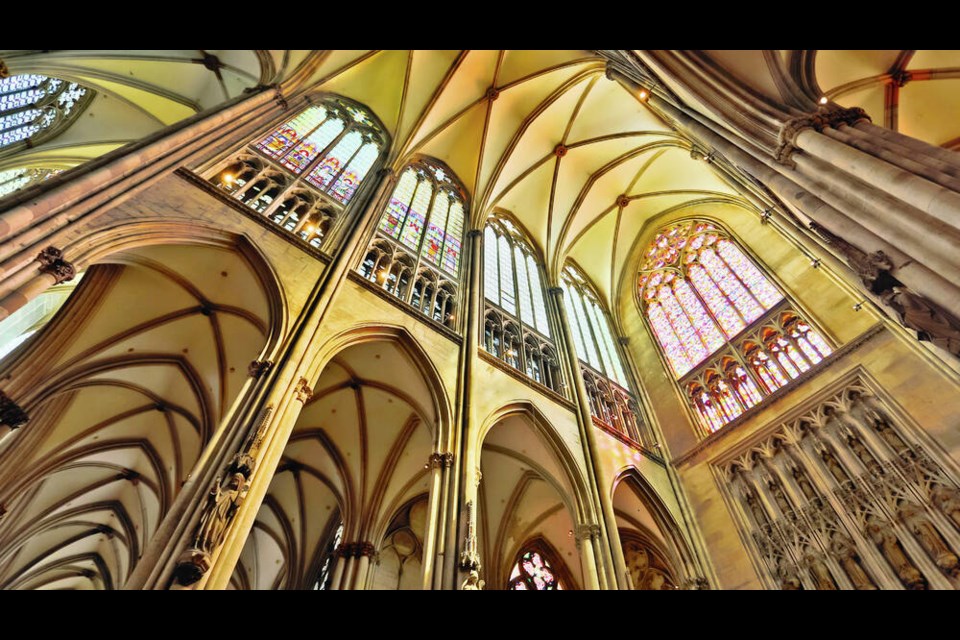On the banks of the Rhine, the city that Germans call “Köln” is home to Germany’s greatest Gothic cathedral, its best collection of Roman artifacts, a world-class art museum, and a healthy dose of urban playfulness.
This river town in western Germany makes an ideal on-the-way stop — it’s a major rail junction, and its top sights are clustered near the train station. With a couple of hours, you can toss your bag in a locker, take a quick town walk, zip through the cathedral and make it back in time for your train.
Stepping out of the train station, you’re confronted with a modern hodgepodge of post-Second World War architecture and the towering icon of Cologne: its cathedral. The city feels rebuilt — because it was.
The Allies bombed Cologne hard in retaliation for Germany’s bombing of London. While 95 per cent of Cologne was destroyed by Second World War bombs, the cathedral held up fairly well. (It was hit by 14 bombs, but the skeletal Gothic structure flexed, and it remained standing.) In anticipation of the bombing, the glass and art treasures were taken to shelters and saved.
Cologne has long been a religious centre — perhaps the most important in Germany. In 1248, its original cathedral burned down as workers were trying to replace it with something more modern — a style we now call “Gothic.” While the current cathedral was built according to its original 13th-century plans, and the left (east) part was completed in the 13th century, the right half wasn’t built until after German unification, in the 1880s.
Step inside and you might notice feeling small — you’re supposed to. The church’s 140-foot-tall ceiling reminds us of our place in the vast scheme of things. Lots of stained glass — enough to cover three football fields — fills the church with light, representing God.
Next to the cathedral are two notable museums — the Roman-Germanic Museum and Museum Ludwig. Through the Roman-Germanic Museum’s generous window, budget travellers can get a free look at the museum’s prize piece — an ancient mosaic floor. Once the dining-room floor of a rich Roman merchant, this is actually in its original position (the museum was built around it). It shows scenes from the life of Dionysus — wine, women and song, Roman-style. Inside the museum, you’ll find an elegant and fascinating display of Roman artifacts: glassware, jewelry and mosaics — evidence of Cologne’s status as an important site of civilization long before the cathedral was ever imagined.
Next door and more enjoyable, Museum Ludwig offers a stimulating trip through the art of the last century, including American Pop, post-Second World War art, and edgy German masterpieces from the Haubrich collection.
Josef Haubrich managed to keep his impressive collection of German Expressionist art out of Nazi hands (they considered it “decadent” art) and eventually gave it to the city. It includes works by the great Expressionists Max Beckmann, Otto Dix, and Ernst Ludwig Kirchner. (All three were hounded by the Nazis, with Kirchner committing suicide in 1938.) Their paintings capture the loss of idealism and innocence following the First World War, and helped take art into the no-holds-barred modern world.
Cologne’s most popular museum — a 10-minute riverfront walk from the cathedral — offers a different kind of decadence. The Chocolate Museum, cleverly billed as the “MMMuseum,” has three levels of displays that follow the cocoa bean from its origin to the finished product.
Local historians, citing the “dumbing-down” of this generation of tourists, complain this museum gets more visitors than all of Cologne’s other museums combined. Some visitors find that the museum takes chocolate too seriously, and wish the free samples weren’t so meagre — you’ll have to do your indulging in the fragrant gift shop.
After tantalizing your taste buds, it’s time to satisfy your sense of smell. Take a walk through the Old Town to 4711 Glockengasse, which claims to be the birthplace of the original Eau de Cologne (Germans call it “Kölnisch Wasser”). In 1810, the inventor stopped calling it medicine and started marketing it as a perfume, putting Cologne on the map. Locals claim Eau de Cologne was the first perfume based on alcohol (86 per cent alcohol; the rest is herbal fragrances). The original “Cologne Water” runs in a fountain by the door.
As you head back to the train station, you realize that modern Germany isn’t sitting on a stump, wearing lederhosen and yodelling. It’s a no-nonsense, lean-and-mean business machine with 80 million people packed into a country the size of Montana. A visit to Cologne gives you a satisfying slice of this 21st-century powerhouse — a bustling commercial and cultural centre that still respects its rich past.
This article is used with the permission of Rick Steves’ Europe (www.ricksteves.com). Rick Steves writes European guidebooks, hosts travel shows on public TV and radio, and organizes European tours.



